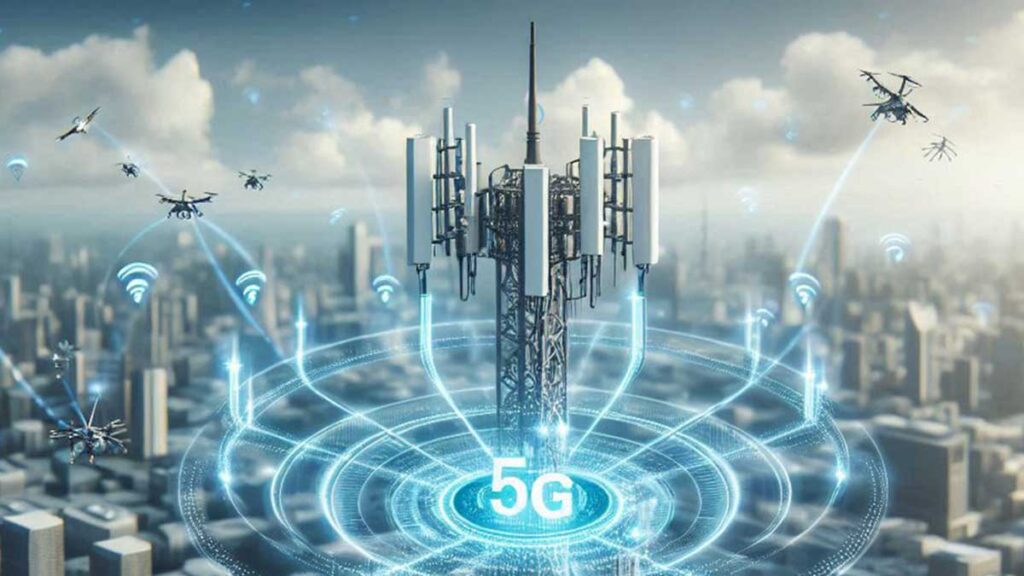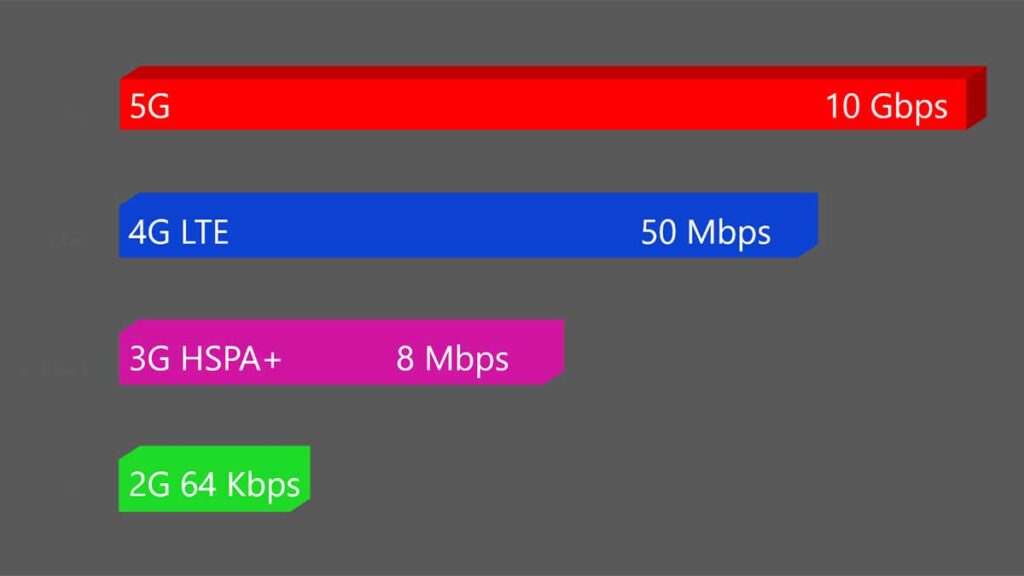
Introduction.
How mobile internet is developing
Remember the big, brick-heavy cell phones of the 90s? With them we could only call and send short SMS. Today, however, our smartphones are powerful pocket computers with which we surf the web, watch high-definition videos and play complex games. This incredible transformation is possible thanks to the development of mobile networks.
From 2G to 5G: The Evolution of the Mobile Internet
- 2G (Second Generation): The first mobile networks that allowed us to talk on the phone and send SMS messages. Data transfer speeds were very slow and connection quality was often spotty.
- 3G (Third Generation): The introduction of 3G brought a significant improvement in data transfer speeds, enabling faster internet surfing and the first mobile video calls.
- 4G (Fourth Generation): 4G networks have revolutionized mobile internet, offering significantly higher speeds and lower latency. This made high-definition video streaming, online gaming and other resource-intensive applications possible.
- 5G (Fifth Generation): The latest generation of mobile networks that provides even higher speeds, lower latency and the ability to connect many more devices simultaneously. 5G will be the basis for the development of new technologies such as autonomous cars, virtual reality and smart cities.
Comparison of 5G with older standards
| Feature | 1G | 2G | 3G | 4G | 5G |
| Download Speed (Mbps) | Not applicable (analog) | About 2-10 | About 200-384 | About 10-100 | About 100-10000+ |
| Latency (ms) | Not applicable (analog) | 150-300 | 100-150 | 20-50 | 1-5 |
| Capacity (number of connected devices per cell) | Very low | Several hundred | Several thousand | Tens of thousands | Millions |
| Main Applications | Voice calls | Voice calls, SMS | Slow browsing, mobile video calls | Video streaming, online gaming, social networking | Virtual and Augmented Reality, Autonomous Cars, Internet of Things, Industrial Internet |
Additional notes on 1G
- Analog technology: 1G networks use analog technology, which does not allow direct measurement of speed in megabits per second (Mbps) and latency in milliseconds (ms) as with digital technologies.
- Main function: The main function of 1G networks is voice communication. Speed and latency were not a priority as there were no applications that required large volumes of data or low latency.
- Low reliability: Due to the analog nature of the signal, 1G networks were susceptible to interference and had limited range.
- Manual switching: Calls in 1G networks were made by manual switching by an operator.
- Slow development: The transition from 1G to 2G has been a slow process as it required significant investment in infrastructure.
Notes:
- Mbps: megabits per second – a measure of data transfer speed.
- ms: milliseconds – a measure of data transfer delay.
- IoT: Internet of Things – a network of physical devices connected to the Internet.
Further explanation of 5G
- Speed: 5G offers significantly faster speeds than previous generations, enabling faster downloads of large files, high-definition video streaming and other resource-intensive applications.</li >
- Latency: 5G’s low latency is key for applications such as virtual reality and autonomous cars, where minimal latency is essential.
- Capacity: 5G can support a much larger number of connected devices per cell than previous generations, which is important for the development of smart cities and Industry 4.0.
- Applications: With each new generation comes new and more complex applications that demand higher speeds and lower latency.
Important: The data in the table is approximate and may vary depending on the specific network, operator and location.
Here is another table with which I hope to clear up the concepts.
| Generation | Popular Names | Abbreviations | Description |
| 1G | Analog mobile network | NMT, AMPS | The first generation of mobile networks used primarily for voice calls. |
| 2G | Digital Mobile Network | GSM, CDMA | Second generation, introduces digital technology and SMS messaging. GSM is the most common standard. |
| 2.5G | GPRS, EDGE | GPRS, EDGE | 2G improvements that enable faster data transfer and Internet access. |
| 3G | Third Generation | UMTS, HSPA+ | Introduces higher data transfer speeds, enables mobile video calling and faster web browsing. |
| 4G | Fourth Generation | LTE, LTE-Advanced | Provides significantly higher speeds than 3G, enables online gaming, high-definition video streaming, and more. LTE stands for Long Term Evolution. |
| 5G | Fifth Generation | NR (New Radio) | The latest generation, offers extremely high speeds, very low latency and supports a large number of connected devices. NR is the new radio interface for 5G. |
- GSM: Global System for Mobile Communications – global system for mobile communications.
- CDMA: Code Division Multiple Access – multiple access with code division.
- UMTS: Universal Mobile Telecommunications System – universal mobile telecommunications system.
- HSPA+: High Speed Packet Access Plus – high speed packet access plus.
- LTE: Long Term Evolution.
Why is understanding these abbreviations important?
- Technical Communication: These abbreviations are widely used in technical papers, articles, and discussions about mobile networks.
- Marketing: Operators often use these abbreviations in their advertising campaigns to highlight the benefits of the services they offer.
- Better understanding: Knowing these abbreviations allows you to better understand the technical characteristics of different mobile networks and make a more informed choice when choosing a mobile plan.
 How mobile internet is developing
How mobile internet is developing
Advantages of 5G
- Faster speeds: 5G allows us to download large files in seconds and watch videos in the highest resolution without buffering.
- Lower latency: Thanks to 5G, online games will be even more realistic and video chats will be lag-free.
- More connected devices: 5G will allow billions of devices to be connected to the Internet at the same time, opening the door to the development of smart cities and Industry 4.0.
Challenges and future
How mobile internet is developing
Despite all its advantages, 5G is still in its early stages of development. Building 5G networks requires significant investment, and coverage in many regions is still limited. In addition, to take advantage of the full potential of 5G, new devices and applications will be required.
Despite these challenges, the future of 5G looks very promising. As technology evolves, we can expect even faster speeds, lower latency, and new innovative applications that will change the way we live and work.
5G and healthcare
- Remote surgery: 5G will allow surgeons to perform operations remotely, with incredible precision and minimal delay. This will enable patients in remote areas to access the best specialists.
- Telemedicine: 5G will improve the quality of telemedicine services, allowing patients to consult doctors in real time, regardless of their location. This will be especially useful for people with chronic diseases or living in remote areas.
- Smart health monitoring devices: 5G will allow more medical devices to be connected to the Internet, allowing doctors to monitor patients’ conditions in real time and respond quickly if needed.
- New medical research: 5G will facilitate the collection and analysis of large amounts of medical data, which will accelerate the development of new drugs and treatments.
5G and education
- Virtual and Augmented Reality: 5G will allow students to immerse themselves in interactive learning environments, making learning more interesting and effective.
- Online learning: 5G will improve the quality of online learning by allowing students to participate in interactive lessons and collaborate with other students from around the world in real time.
- Smart campuses: 5G will enable universities to create smart campuses where buildings, devices and infrastructure are connected and can be managed efficiently.
5G and other areas
- Automotive industry: 5G will be a key technology for the development of autonomous cars that will be able to communicate with each other and with the infrastructure.
- Industry 4.0: 5G will enable enterprises to create more efficient and flexible production processes by connecting machines, robots and other devices in a single network.
- Smart cities: 5G will play an important role in creating smart cities where infrastructure, transport and services are optimized using sensors and data.
To summarize, 5G will revolutionize many areas of our lives, such as:
- Improving health: Better diagnosis, treatment and prevention of diseases.
- Improving education: More interactive and personalized learning.
- Increase productivity: More efficient production processes and better management of resources.
- Creating new opportunities: Development of new products, services and business models.
Conclusion
How mobile internet is developing
The road from 2G to 5G has been long and full of innovation. 5G represents the next big step in the evolution of mobile technology and promises to change the way we interact with the digital world.
Should we be afraid of 5G?
The short answer is: “No!”. 5G networks, as the latest generation of mobile technology, are often the subject of much speculation and concern about their health effects. Normally, we always have concerns about new technologies. To date, there is no conclusive scientific evidence linking exposure to radio frequency waves from 5G networks to any serious health problems. Many of the concerns often spread in the media are based on unproven theories and analogies with other types of radiation. Commercial interests are definitely involved in the speculation. The World Health Organization, as well as numerous national regulatory bodies, have conducted extensive research. They concluded that the radiation levels emitted by 5G antennas are significantly below the safe limits set by international standards.
Feel free to share your opinion in a comment.



